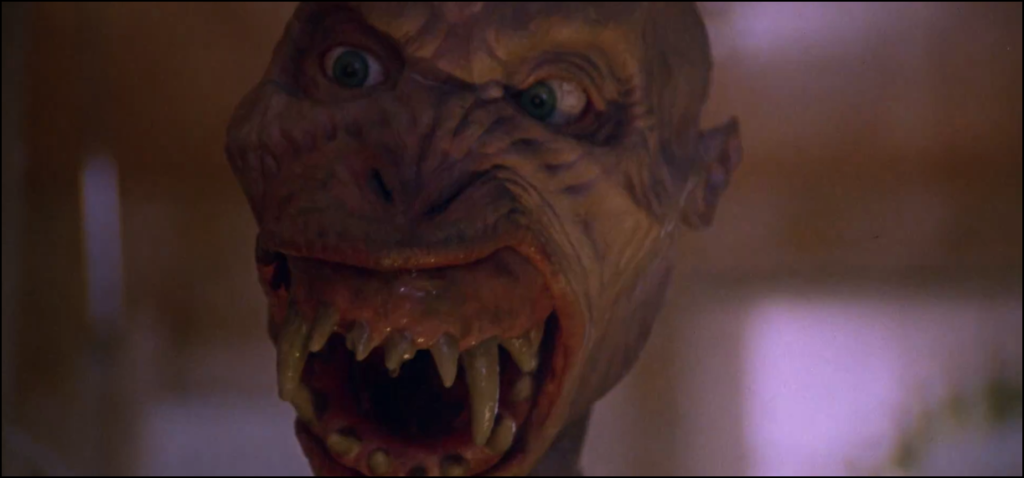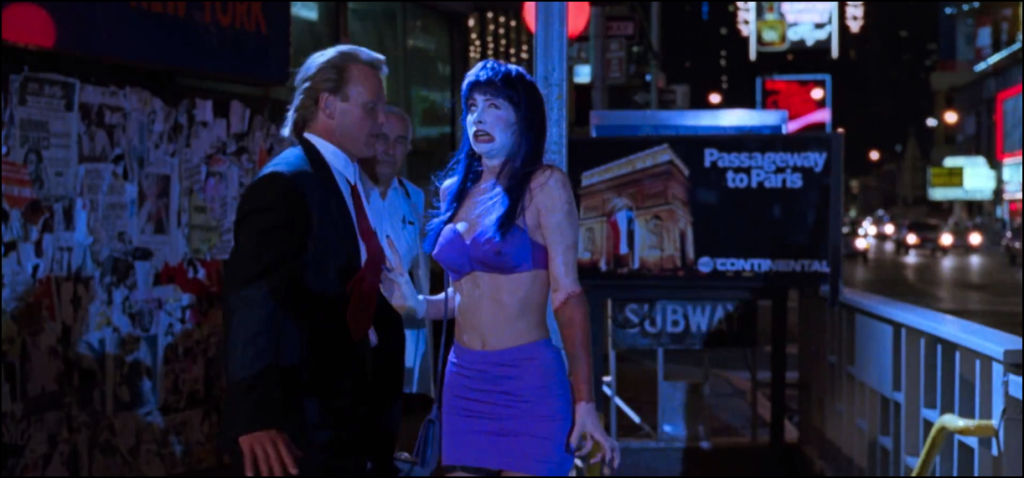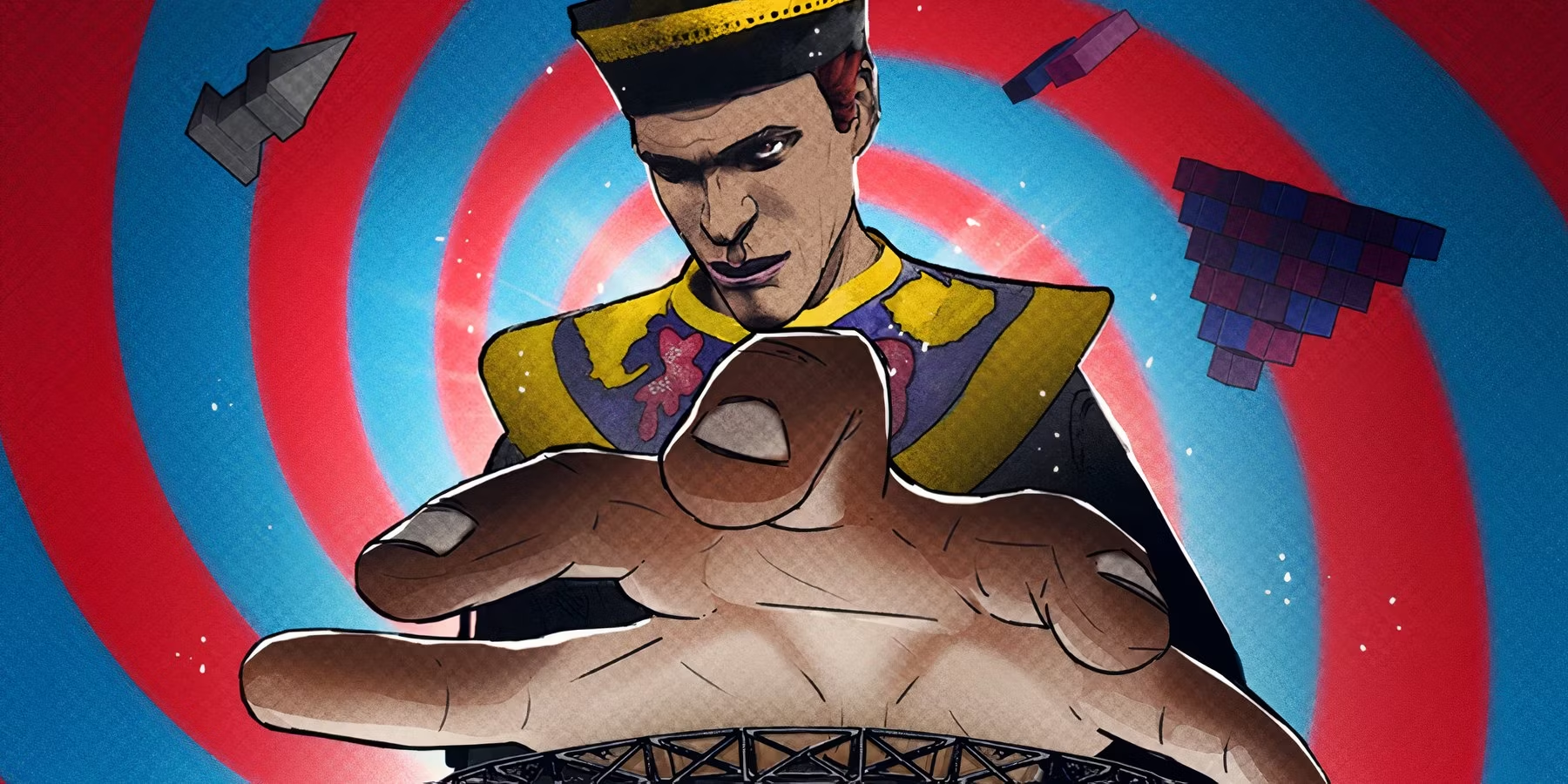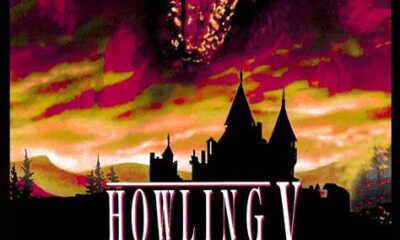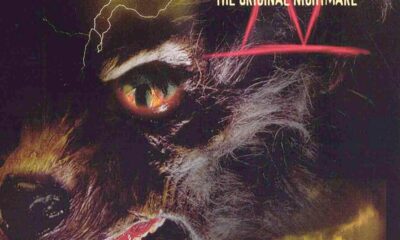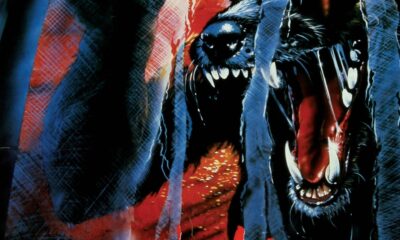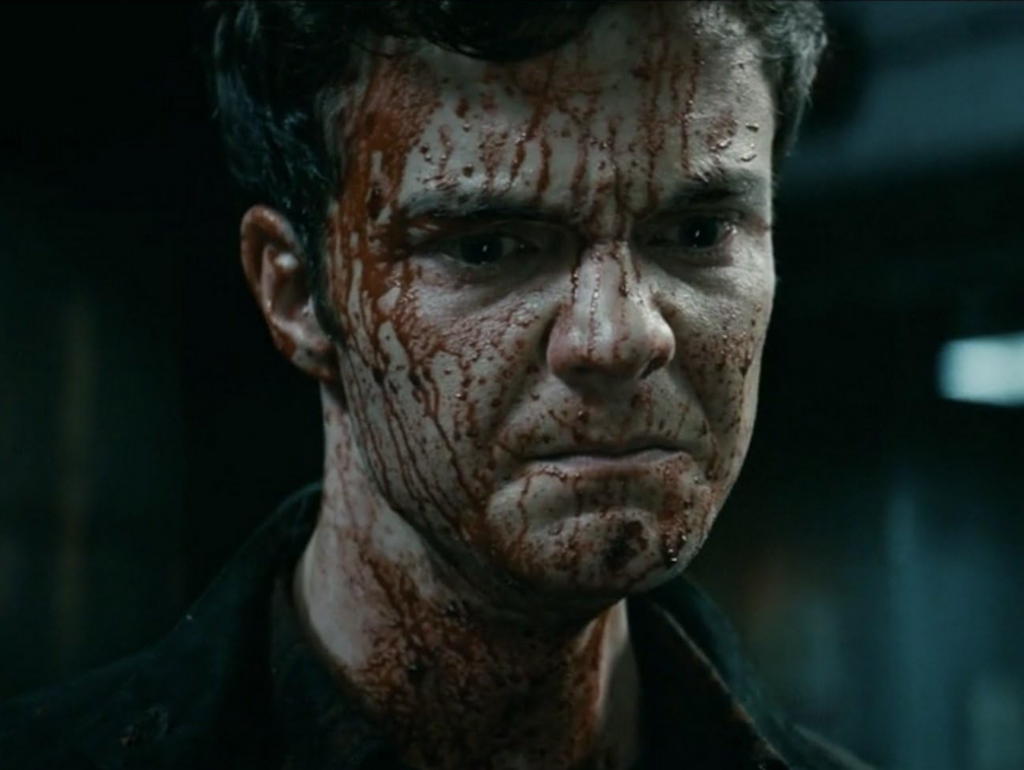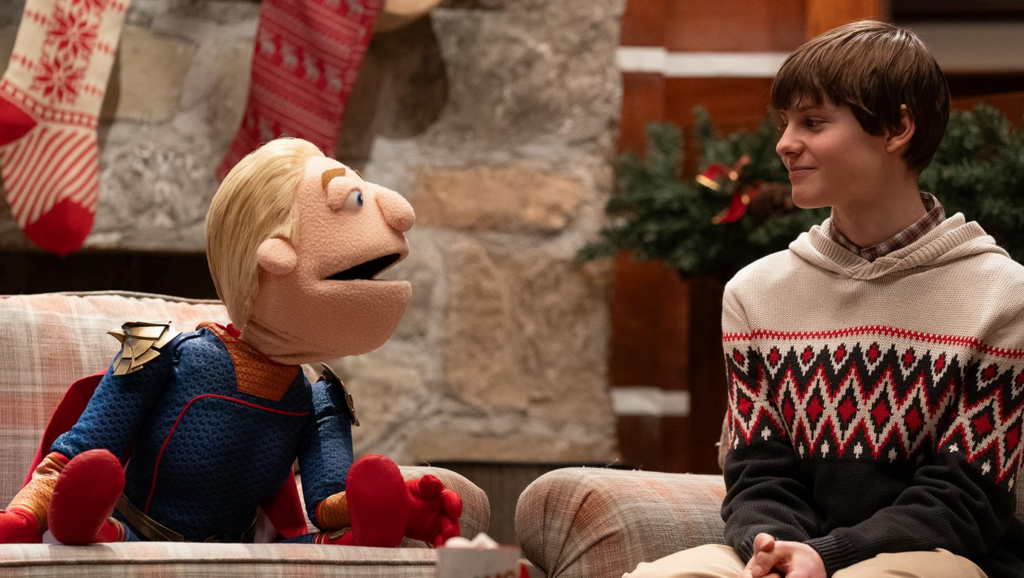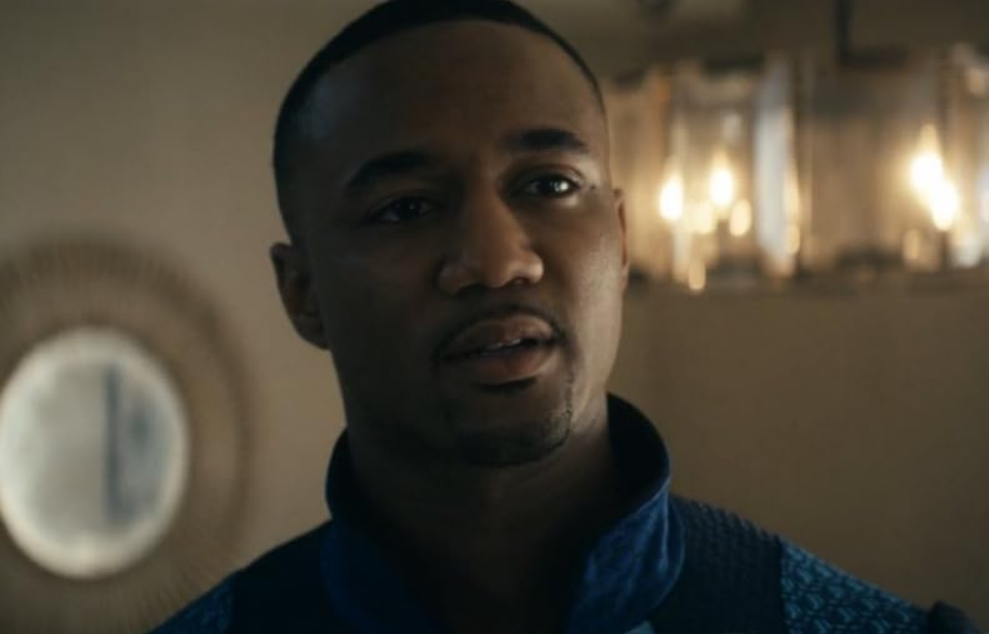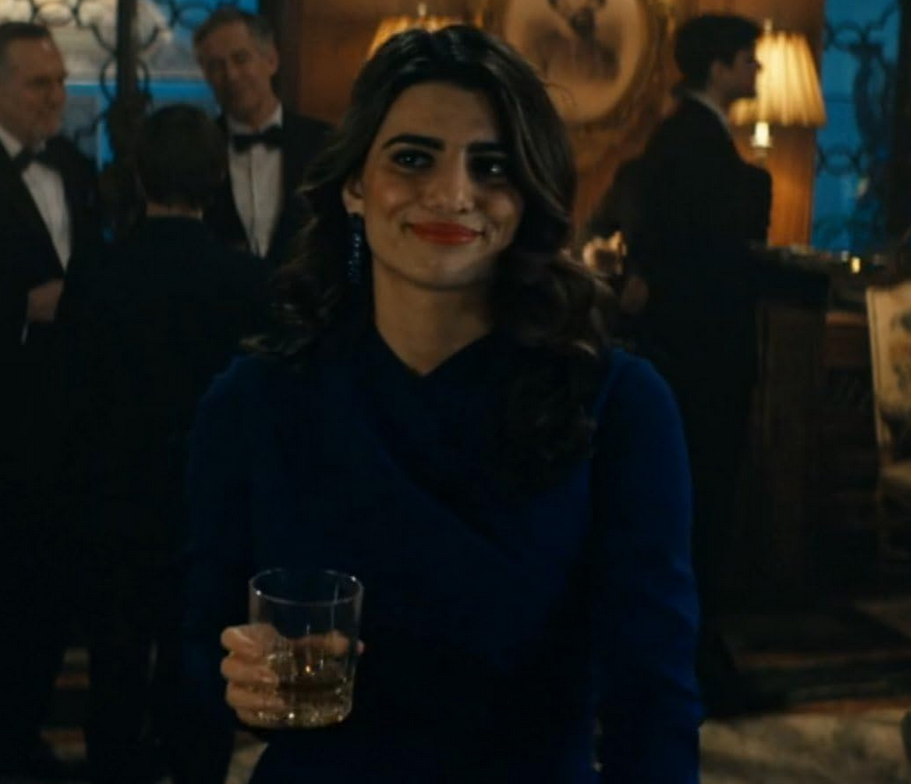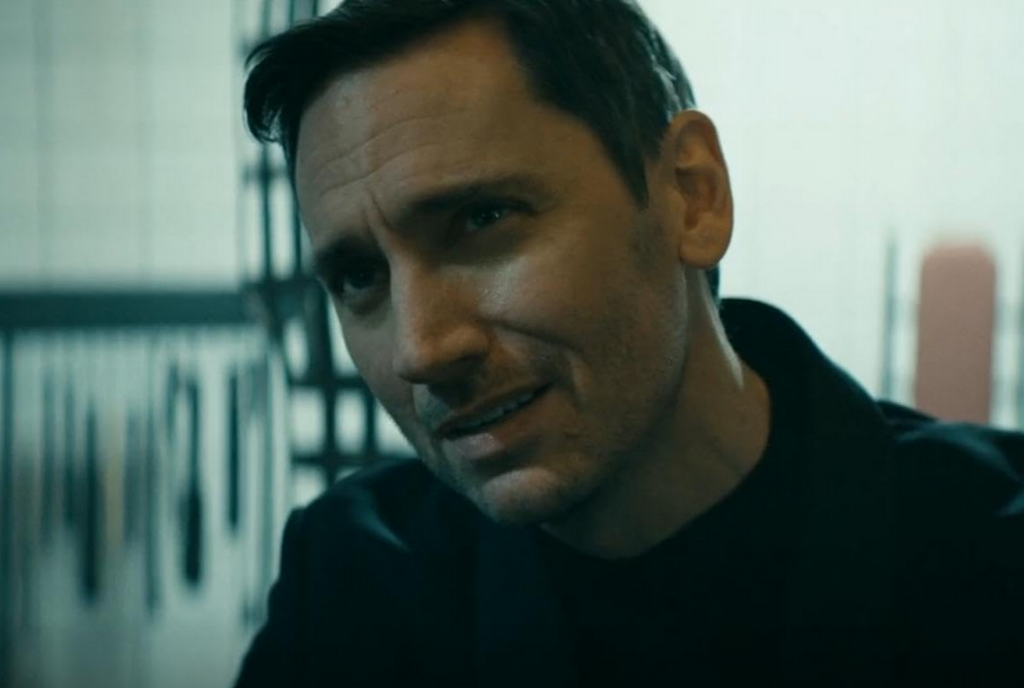
Notes from the Last Drive-In: Heartbreak Trailer Park
More Videos
Published
2 years agoon
We’re going to Joe Bob’s Heartbreak Trailer Park for a celebration of love… of a kind! Welcome to Haunted MTL’s “Notes from the Last Drive-in,” where we cover the fun of Shudder’s best series featuring the venerable Joe Bob Briggs. In a special Valentine’s Day event, we feel the love as Joe Bob welcomes special guests to the trailer, including The Boulet Brothers from Shudder’s Dragula, as well as Drive-In legends Frank Henenlotter and James Lorinz.
So, the question is, did viewers feel the love during Joe Bob’s Heartbreak Trailer Park? Did the night’s films, Black Roses (1988) and Frankenhooker (1990), leave the fans fulfilled?
Let’s find out.
Why is "devil sex" different than regular sex?
It is a little hornier.#thelastdrivein @therealjoebob @kinky_horror @shudder— Haunted MTL 🏳️🌈 (@HauntedMTL) February 12, 2022
Black Roses (1988)
I wish the occult section of my local library was half as thorough as the one in Black Roses.#thelastdrivein @therealjoebob @kinky_horror @shudder— Haunted MTL 🏳️🌈 (@HauntedMTL) February 12, 2022
Black Roses is a 1988 metalsploitation horror film directed by John Fasano. The movie stars John Martin, Ken Swafford, Julie Adams, and Carla Ferrigno. It also features an impressive soundtrack of metal, including Tempest, Lizzy Borden, and King Kobra. The members of King Kobra would make up the Black Roses in the film.
The film follows a teacher at a high school (Martin) who grows concerned about the effect a band, Black Roses, is having on normally straight-laced students in the town of Mill Basin. The town’s parents express concern, but the demonic frontman of the band tricks them as he pulls more of the local children under his thrall.
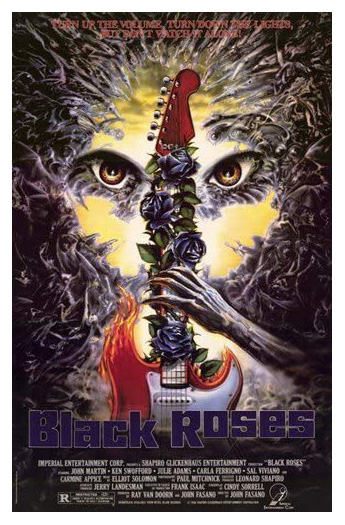
The story isn’t great. This Satanic Panic metal film plays on the anxieties of the censorship crowd by presenting a movie that makes the case that maybe metal does push kids to bad behavior. The film is a satire, but the film doesn’t quite hit the satirical note to be very effective. Broadly, I found myself wishing the film were a little more extreme in its depictions of chaos. The town under Satanic influence seems localized to a block or two, and most of the bad behavior is pretty minor in the grand scheme of things. The film would have been stronger if it had given into excess as the titular band urges.
The performances are nothing to write home about either. John Martin as Matthew Moorhouse, the teacher, is good given what he has to work with. But really, the most memorable thing about the cast I recall is a brief appearance by Vincent Pastore, “Big Pussy” himself, screaming as he gets eaten by a monster spawned from a record. Not even screen-horror-legend Julie Adams does much here, playing a social crusader who doesn’t get a lot to work within the film’s scope.
Visually, this film doesn’t offer much beyond a handful of fun creature effects. The framing is primarily flat and budget-friendly, much like the Canadian tax shelter used by the production. I wasn’t overly impressed with how the film looked. With that said, the creature effects were a lot of fun, as practical effects usually are. It just feels so small-scale and feels like a direct-to-video affair, which it was.
The real appeal of the film comes from the music. Bang Tango, Lizzy Bordon, Hallow’s Eve, and Tempest are among the bands who contributed to the soundtrack. As for the fictional Black Roses, the band comprises actual metal performers, most notably Carmine Appice of Cactus, King Kobra, and Blue Murder.
Though, from the director of the MST3K staple Zombie Nightmare, I expected a bit more of this movie. Especially given it is a favorite of the Boulet Brothers, the first guests of the evening.
Joe Bob-servations on Black Roses
Our venerable host Joe Bob Briggs was joined at the “Heartbreak Trailer Park” by the Boulet Brothers of Dragula fame. Overall, the guests and the host were affable and played well off one another, with Joe Bob asking about the world of horror drag and the Boulets’ party scene between dispensing information about the film. It is an example of shrewd calculation of Shudder’s part to take two popular shows and generate some crossover viewership. Still, it is ultimately fun, and there is no shame in that at all, especially with how fantastic the Boulet Brothers are as guests.
The Boulets offer a fun way to introduce a little glamour and filth onto The Last Drive-In, and as a whole, the Valentine’s Day angle worked well enough. It helps that Swanthula and Dracmorda Boulet are generally game and quick on their feet. Their story about the “teacup incident” is one of the grosser things presented on the show in the first half of the evening.
It wasn’t just Dragula getting a nod in the show during the night, either. Another Shudder original Creepshow has a connection to Black Roses in that one of the Creepshow writers, Frank Dietz, played the evil frontman of the band in the movie. Probably one of the most interesting Joe Bob factoids in the first half of the evening.
Final Thoughts on Black Roses
Black Roses is generally fun as a direct-to-video oddity, but it is ultimately too toothless to be satire and too tame to be a drive-in masterpiece. Joe Bob Briggs gave Black Roses 3 stars, but I think it was given a bump given it was a guest selection.
I can’t see myself giving Black Roses anything greater than 2-and-a-half Cthulhus. I had fun, but I think it was more because it was on The Last Drive-In rather than the merits of the movie itself. The real appeal of the film comes from the metal soundtrack.
 (2.5 / 5)
(2.5 / 5)
Best Line: “I’m going home… Or maybe to a bar, yeah, whichever I pass first.” – Matt, speaking for all teachers, everywhere.
Frankenhooker (1990)
Yes…and it’s VERY expensive!! 😋 #TheLastDriveIn #HeartbreakTrailerPark #Frankenhooker https://t.co/NUTOumL6Dx— Diana “Darcy the Mail Girl” Prince (@kinky_horror) February 12, 2022
Now 1990’s Frankenhooker is what I expect from The Last Drive-In and is a perfect Valentine’s Day movie for the “Heartbreak Trailer Park.” Frankenhooker is a black comedy horror film directed by Drive-In legend Frank Henenlotter. The movie stars James Lorinz and Patty Mullen, a former Penthouse Pet.
The film follows the ambitious experiments of a power plant worker and medical school drop-out, Jeffrey Franken, who seeks to revive his fiance, who died in a tragically avoidable accident. Only he also plans on making a few upgrades, pulling him into the shady world of sex workers on the streets of New York to build his bride.
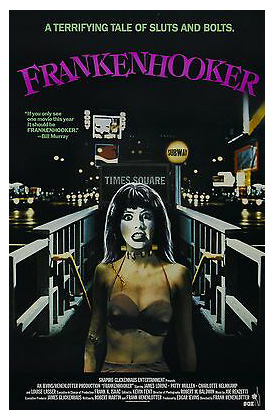
The film is a hilarious play on the classic Frankenstein story and offers incredibly dark comedy. Exploding bodies, piles of human limbs and breasts, self-regulating through a power drill in the head. The film is like a pitch-black cartoon and carries the same ridiculously fun energy of Frank Henenlotter’s other Drive-In classics like Brain Damage and Basket Case. Frankenhooker is, ironically enough, Henenlotter’s most mainstream film of his 80s and 90s output, but even then, it still revels in excess in the best way possible.
A lot of this film boils down to the performances of Lorinz and Mullen, and they each absolutely sell the hell out of this movie in their wildly different purposes. Lorinz carries the film as Jeffrey, a slightly amoral scientist who jump-starts his thought process via a power-tool lobotomy. Lorinz plays Jeffrey as sympathetic and worthy of scorn within the same scenes. While I am sure another actor could have delivered on Jeffrey, I can’t think of any. Lorinz owns the role.
Mullen, however, has a much smaller part in the film. Her character dies nearly immediately, and she does not get revived until the third act, where Mullen shines in this brief time as the undead streetwalker with a heart of gold who shouts “Wanna date?” and “Got any money?” to confused onlookers. Mullen plays this up wonderfully, and it’s no wonder that her delivery has become an iconic part of why this film is beloved among drive-in mutants.
The film looks pretty great, shooting on location for New York’s scenes, while the suburban setting of Jeffrey’s neighborhood and garage evoke a strange sense of whimsy I feel is akin to Edward Scissorhands. That being said, Frankenhooker is nowhere near as wholesome as that film – it is funnier, though. Regardless, cinematographer Robert M. Baldwin did well in shooting these two worlds. After all, there is a world of difference between New Jersey and New York.
Frankenhooker is one of those films that works as a thesis statement for The Last Drive-In. If it were in that inaugural marathon back when we thought this would be Joe Bob’s last rodeo nearly four years ago, this film would have been the highlight. It has blood, breasts, and beasts, features a drive-in legend is Joe Bob’s friend, Henenlotter, and is funny as hell.
Joe Bob-servations on Frankenhooker
Frankenhooker is dearly a beloved film by both Joe Bob and Darcy, and there was a much more enthusiastic feeling around it than Black Roses. Drive-In Mutants, in general, love the film. The only way to make a showing of Frankenhooker better is to bring on the man himself, Frank Henenlotter, to talk about it. He not only brought his memories but a prop breast for the show and even managed to bring James Lorinz with him.
Hearing Joe Bob and Frank talk as friends and movie fans proved incredibly compelling. Mainly because they took the time to find their little indulgences, such as a discussion of Herschell Gordon Lewis. Hearing all three of the men discuss various interpretations and trivia about the movie was also entertaining as Frank can sometimes be a bit cantankerous in a funny way. Really though, Frank Henenlotter knows how to control the room.
Maybe one of the best bits of the night was the discussion of Robert “Uncle Bob” Martin, co-writer of Frankenhooker, who first met Henenlotter while working on a novelization of Brain Damage. Martin would be an essential figure to horror, as he was the original editor of Fangoria. Horror is often the domain of outsiders who find one another, and hearing these stories shows how tightly knit this community can be.
Final Thoughts on Frankenhooker
Every once in a while, The Last Drive-In plays a movie that can easily be declared the ultimate Drive-In movie. This time it is Frankenhooker. The film delivers on the promise of The Last Drive-In as a concept and evokes so many fun associations in drive-in movie history.
Frankenhooker makes the Heartbreak Trailer Park. Joe Bob gave Frankenhooker 4 well-deserved stars, a grade he would have given even if his friend Frank wasn’t on set. I am in agreement with our host on this one. Frankenhooker is a 5 Cthulhu film.

Best Line: “Yeah – Well so am I, Ma. Something’s happening to me that I just don’t understand. I can’t think straight anymore. It’s like my reasoning is all, uh, twisted and distorted, you know? I seem to be disassociating myself from reality more and more each day. I’m anti-social. I’m becoming dangerously amoral. I – I’ve lost the ability to distinguish between right from wrong, good from bad. I’m scared, Ma. I mean, I feel like I’m – I’m plunging headfirst into some kind of black void of sheer and utter madness or something.” – Jeffrey, knowing himself.
Haunted MTL Drive-In Totals
As usual, we have the totals direct from the show. Thanks, Shudder!
“Heavy metal stampede?" Back in 2020, Joe Bob gave Henenlotter's BRAIN DAMAGE four stars, so that's two perfect scores for two cult classics. #TheLastDriveIn pic.twitter.com/3ueqew625t— Shudder (@Shudder) February 12, 2022
That’s what we like to refer to as either a “mosh pit” or a “wall of death."#TheLastDriveIn pic.twitter.com/jPIz2r6QeC— Shudder (@Shudder) February 12, 2022
As for the Haunted MTL Drive-In Totals, we have…
- 2 Darcy Cosplay
- 4 Guests
- 40 years of praise for Frankenhooker
- 97 million women buying potpourri
- 196 Million Roses on Valentine’s Day
- Gratuitious Big Pussy
- Grautitous Drag, Filth, Horror, and Glamor
- Gratuitous Musical Performances
- Topless Monster
- Bodyless Tops
- Brain Drilling
- Sex Club Joking
- United Way Joking
- Teacup Storytelling Fu
- Karaoke Fu
- Poetry Fu
- Overly Involved Teacher Fu
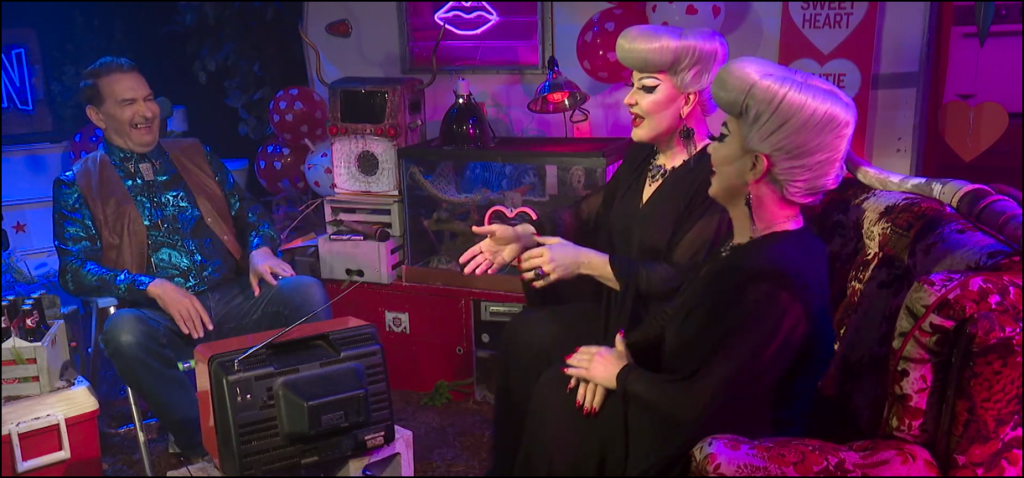
Joe Bob’s Heartbreak Trailer Park Episode Score
Overall, this was a solid special for Valentine’s Day. Both sets of guests were very entertaining. Each group of guests provided a different kind of compliment to their respective movie. The Boulet Brothers were able to share a film they loved that maybe wasn’t my favorite of the evening, still had a level of camp, and made for a fun evening. Likewise, Frank Henenlotter and Frank Lorinz gave us the Valentine’s Day gift of a love letter to drive-in movie culture.
Throw in a couple of Darcy cosplays, karaoke interludes, prop limbs, and one shocking story about a teacup you have for a pretty memorable Valentine’s Day.
Don’t you just feel the love? I give “Joe Bob’s Heartbreak Trailer Park” 4 Cthulhus.

And with that, Notes from The Last Drive-In takes a break until the next special or seasons of The Last Drive-In with Joe Bob Briggs – whichever comes first. We’ll keep an eye out for the return of Joe Bob and Darcy on Shudder this year. We will continue to cover the show as it continues to air new episodes and specials.
Please let us know what you think of the review and recap. We would love to read your comments about the films as well. Please let us know what you think.
Until next time, Mutants.
Again, this conversation is a great example of why Shudder should give Joe Bob a weekly talk show. #thelastdrivein @therealjoebob @kinky_horror @shudder— Haunted MTL 🏳️🌈 (@HauntedMTL) February 12, 2022
Want to Buy the films mentioned in the review?
David Davis is a writer, cartoonist, and educator in Southern California with an M.A. in literature and writing studies.

You may like
We have come now to the finale of season four of The Boys. And while it didn’t have the literal blood fireworks I wanted, someone did get ripped in half in the air. So, that’s pretty close.
As a note, I will try to avoid spoilers as much as possible. This ending was a hell of a gut punch that should be experienced as blindly as possible. That being said, I will not be able to avoid spoilers and still give a full legitimate review. Proceed at your own risk.
The story
The main storyline for this episode is the attempted assassination of President-Elect Robert Singer. The Boys join forces with the Secret Service to protect him. But, as we learned last episode, Annie has been replaced with a shapeshifter. A shapeshifter that was welcome not just into Hughie’s anus, but into the protective bunker in which the President-Elect is hiding.
What worked
The first thing I want to discuss about this episode is the ending. But we need to do this carefully.
The important thing here is that the ending breaks your heart on so many levels. So many terrible things are happening to characters that it’s almost hard to keep track. And each moment is significant to each character.
I cannot give a specific example. But no matter who your favorite character is, you’re going to weep for them.
Unless your favorite character is Sage. And this is the next thing that made this episode so fantastic.
I don’t think I’m spoiling anything to say that Sage’s plans worked out exactly as she wanted them to. And she got exactly what she wanted.
What she wanted wasn’t power. It wasn’t money or fame or vengeance. It wasn’t to win the love of anyone. She just wanted to see if she could do it.
That is a terrific, terrifying motivation! Because all she wants is to play a massive game of chess with people as pieces. She doesn’t care about anyone. She just wants to see how many people she can manipulate. She just wants to set things on fire to see if she can.
Fantastic. A plus villain work.
The next thing I want to discuss is a cornerstone of the whole series.
The morality of The Boys shifts through the series. While it’s very much a battle to save the world from overpowered super monsters, it’s also a battle for the souls of our real heroes. And in that battle, there are two warring factors. We have Hughie, always trying to bring everyone up to a better level. And we have Butcher, who has no problem at all hitting rock bottom with a shovel in hand to do some more digging.
In this episode, we saw almost every member of The Boys challenged. Will they rise to their higher angels, or sink with their demons?
On a similar note, I am so glad that the writers kind of addressed my issues with Annie. They did this by having the shapeshifter get right into her face and accuse her of thinking that she’s better than everyone.

While that was devastating for the character, it was a little cathartic for those of us who felt like Annie was a little too good of a good guy.
What didn’t work
This is a small matter, but it is an issue that I want to address. After Annie finds out that Hughie slept with her doppelganger, she is furious at him.
In addition to this being unfair, it’s also a very cliche element to add. In almost every instance of a lookalike in fiction, there’s a moment where the love interest of the victim is fooled. Or almost fooled. And it’s always the same fight. It’s just played out and predictable. I’m just glad that it didn’t last very long.
Now that we’ve come to the end of the season, I can officially say that it was amazing. The story was deep and rich. The special effects were a stomach-turning good time. The character development was spot-on and satisfying. And, of course, it left me just about gagging to see what happens next. Unfortunately, it looks like we’ll have a bit of a wait. Because as of right now, the fifth season isn’t expected until 2026.

We’ve reached the second to last episode of The Boys, season four. And, as is appropriate for the penultimate episode of any show, things have to get a lot worse before they can get better.
Let’s discuss.
The story
Christmas is coming, and the whole world is getting ready. Ryan, despite being very clear that he didn’t want to appear on any TV shows or movies, has been strong-armed into participating in a Vought puppet Christmas special. He draws the line, though, when asked to sing about turning one’s parents in if they start talking about woke things.
Meanwhile, The Boys are trying to keep each other together. Butcher decides to take Sameer to the rest of the team. He also gets Frenchie out of prison, hoping they can make the Sup virus necessary to finally take down Homelander. Instead, this decision means disaster for one member of the team.
What worked
I first want to talk about Ryan’s speech near the end of the episode. Because it was exactly the moral of this whole story.
Ryan’s dad is a monster. His stepdad is also kind of a monster. But Ryan is a good kid. He cares about people, about family. And while he loves Homelander and Butcher, he doesn’t want to be like them.
Even better, this speech sounded like something a kid would say. Ryan didn’t open his mouth and start sounding like a college student all of a sudden. He sounds like a kid who misses his mom and wants to live up to the good standards she set for him. And I think that’s terrific.
Speaking of Homelander, he shot himself in the foot in this episode. I said earlier in the season that his hubris was going to be his downfall, and I was right. Without Sage, he just has the same weaknesses he’s always had. He’s going to fail because he just isn’t clever enough or patient enough to succeed.
Without Sage, I think a win is in the bag for The Boys. This isn’t to say that Homelander by himself isn’t dangerous. It’s just that he’s more like a wildfire than a controlled burn. He’s going to cause a lot of damage, but not get anything he wants out of it.
More’s the pity for him and everyone else who has to share his world.
Finally, I am thrilled with A-Train’s redemption story. I love that he wants to be a good person not to save himself, but to be a good person. His honest, pure and warm reaction to that little kid smiling at him in the last episode was heartwarming. It changed him in a moment, bringing to light a goodness that he’s been keeping under wraps for a long time.
This, along with Ryan’s courageous speech, proves once again what The Boys does so well. Yes, it’s gruesome. Yes, there’s blood and balls and batshit events. Yes, someone occasionally gets ripped in half. But there is a true human goodness in the story. One that we catch glimpses of. There are good people among the monsters. There is hope for redemption.
What didn’t work
Of course, so few things in this life are perfect, and this episode was no exception. For instance, I was irritated by the insinuation that Butcher cheated on his wife.
That just doesn’t make any sense. We’ve seen flashbacks of Billy and Becca. They were happy. He was happy. He was head over heels for her. And I don’t think it’s realistic or necessary for the character to throw in that he cheated. It does nothing to add to the story, it’s just a weird and offputting moment.
Doesn’t Butcher have enough to hate about himself? Can’t we just give him that at least he was a good husband?
Finally, I kind of hate that we ended up with Annie being caught. It’s just cliche, which is something I don’t normally say about this show. It feels lazy unless they do something very clever with it in the last episode. Which, I suppose, they might.
Next up is the season finale. And with this season being as insane as it has been, I’m expecting nothing short of bloody fireworks. And I mean literal fireworks of blood. At this point, would it surprise anyone?
 (4 / 5)
(4 / 5)
Episode six of The Boys was one of the most surprising episodes of the series so far. And that is certainly saying something. Because this season has so far been bonkers.
The story
Our episode today revolves around a party at Tek Knight’s lovely mansion. Yes, it does look just like Wayne Manor.
The Boys know that Tek Knight is working with Homelander on something, but they don’t know the details. So they decide to send Hughie in to bug the mansion.
Because that’s worked so well the other two times he’s tried to hide a bug!
It should surprise no one that this time goes no better. Hughie finds himself in Tek Knight’s basement. And by that I mean his BDSM dungeon.
Meanwhile, the party upstairs is no less disturbing. Homelander and Sage are trying to convince some well-off political donors to support a cue after the election. When pressed for details on his plan, Homelander freezes. He looks to Sage for help, but she wasn’t recently shot in the head and still in the junk food stage of her healing.
Fortunately, or unfortunately depending on your point of view, Neuman jumps in and saves the day.
What works
If I’m going to say one thing about this episode, it didn’t hold back at all. I didn’t expect them to show a character masturbating, sitting their bare behind on a cake, or spraying breastmilk into someone’s face. But every time I thought they’d cut the scene and let something be left to our imagination, they did not do that.
This is a dangerous move. Whenever you show the monster, you run the risk of them not being scary enough, or gross enough. As Stephen King says in Danse Macabre, to leave this sort of thing to the imagination if the reader makes things so much worse. So when they finally experience the monster, they might say that this isn’t so bad. It could have been so much worse.
But in this case, they managed to avoid that by making the scenes, especially the ones in Tek Knight’s dungeon, so much worse than I imagined it would be.
What doesn’t work
While this was a deeply disturbing episode in many ways, there was one really innocent and sweet moment.
And yes, I did have a problem with it.
Confronted by Firecracker, Annie decides to apologize for spreading rumors about her when they were kids. She tells her that she is genuinely sorry.
And I believe her. I don’t think Firecracker did, but I did.
So why is this an issue? Because I’m starting to think that Annie is maybe too nice. She is too good.
I know that Annie is our good guy. But every one of the other good guys has flaws. Hughie let his pride get in the way and took Temp V. MM hid himself from his daughter instead of teaching her to work through her emotions. Kimiko is far too closed off and has a hard time trusting others. Frenchie numbs himself with drugs. And well, what hasn’t Butcher done?
It is unrealistic that Annie is just so kind and so flawless. We all have shadows in our personalities. We all have weaknesses, we all mess up. We all do things we wish we could take back. The fact that Annie doesn’t seem to have anything like that is not just unrealistic. It’s infantilizing.
Give her some deep dark secrets. Give her something real to regret.
This was a shocking episode, even for someone fairly jaded like me. I wasn’t expecting the sort of weird sexual depravity, though I guess maybe I should have seen it coming. It was dark, upsetting, tense, and funny as hell. And with just two episodes left in the season, I can imagine the stakes are only going to get higher.
 (4 / 5)
(4 / 5)
By the way, if you like my writing you can get my short story, Man In The Woods, on Smashwords and Amazon.

